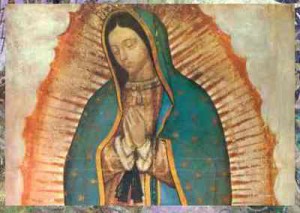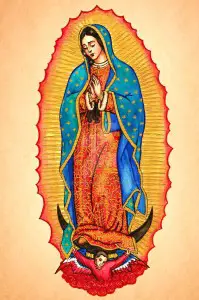Podcast: Play in new window | Download
Subscribe: Apple Podcasts | RSS
 She appeared in 1531 on Tepeyac Hill and proclaimed “I am your mother” to the humble native man named Juan Diego. In this podcast we explore the Virgin of Guadalupe, her relevance and her message for humanity.
She appeared in 1531 on Tepeyac Hill and proclaimed “I am your mother” to the humble native man named Juan Diego. In this podcast we explore the Virgin of Guadalupe, her relevance and her message for humanity.
Our guest for this podcast on a Skype call from Mexico is Javier Magdaleno, a 30-year Guadalupano, and a member of the Archcofraternity of the Virgin of Guadalupe, an auxiliary group attached to the Basilica of the Virgin of Guadalupe in Mexico City. After a brief background of the apparition by the podcast host, Javier talks about the Virgin, her message and what she means in our modern day. This is a living image of the mother of Jesus, as sanctioned by the Catholic Church, and her message is one of faith, love and harmony. Magdaleno asserts that Our Lady of Guadalupe helped usher in a “civilization of love” to replace the fear-based ways of the previous civilizations of Mexico. In the end, the Virgin’s message is for all humanity and anyone in need can call on her for answers.
She has many names: Queen of Mexico, Empress of the Americas, Protectoress of the Unborn, La Virgen Morena and Mother to us All. She is known formally as the Virgin of Guadalupe, a uniquely Mexican apparition of the Virgin Mary.
Just twelve years after the Spanish arrived in Mexico, on December 9, 1531, a recently baptized Indian man named Juan Diego was walking near Tepeyac Hill right outside Mexico City when he heard beautiful music that sounded like the singing of birds. A cloud appeared and then an image of the sun formed around what appeared to be a young woman dressed like an Aztec princess wearing a cloak full of stars. The woman spoke to Juan Diego in his own language, Nahuatl, and told him not to be afraid. She also requested that a chapel in her honor be built on the top of the hill. Juan Diego went down into Mexico City to tell the Bishop of Mexico, Juan de Zumárraga, of what he saw and heard, which would be later referred to as the First Apparition.
The Second Apparition occurred later that day when Juan Diego returned to the hill. He told Virgin that he had failed with the bishop but she told him to persist. The Virgin was emphatic that a temple devoted to her must be built on that hill and that he could not fail again. Juan Diego promised to try again and then retired to his home.
The next day Juan Diego returned to the bishop’s residence to plead with him again to do as the Lady on the hill requested. Zumárraga told Juan Diego that he needed a sign from this mysterious woman, something that would prove to him that this was Mary, the mother of Jesus Christ. When Juan Diego left, the bishop had him followed but the people following him lost track of him when he crossed a ravine and returned to the bishop with no information about the hill or the mysterious woman. When Juan Diego returned to Tepeyac, the Virgin was waiting for him there. This is known as the Third Apparition. Juan Diego expressed his regret in not being able to convince the bishop for the second time and told the shimmering woman that the bishop requested some sort of sign to prove that what he was saying was true. The Virgin then told Juan Diego to return in the morning and she would provide him with what was needed.
Juan Diego did not return in the morning. His uncle, Juan Bernardino, was very sick and Juan Diego tended to him and even arranged for a doctor’s visit. The visit to the lady on the hill was on his mind, but he couldn’t tear himself away from his family responsibilities. The following morning, Juan Bernardino was not feeling better and asked Juan Diego to go into town and get a priest to make his last confession and to absolve him of all of his sins before he died. Juan Diego did as his uncle wished, but in order to go into town, he had to pass by the hill at Tepeyac. He was a little reluctant to do so because he missed his meeting time with the lady on the hill the previous morning. When Juan Diego skirted the hill the woman appeared again, behind the rays of the sun and in a cloudburst as she had done the other times. This encounter is known as the Fourth Apparition. The Virgin consoled Juan Diego and told him that there was no need for him to get a priest or any more doctors because his uncle had already been healed. On to the matter of the sign to present to the bishop, the lady told Juan Diego to climb to the top of the hill and to gather the flowers at its crest. Juan Diego ascended Tepeyac Hill and was surprised to see vibrantly colored Castilian roses in full bloom at the top of the hill. This was strange because it was December and the frosts had already come and the area was desolate and devoid of flowers. Juan Diego gathered some of the beautiful dew-covered roses in his cactus-fiber cloak, known as a tilma, and went down to the heart of Mexico City to deliver this celestial sign to Bishop Zumárraga. When he got to the bishop’s palace to request an audience, the people there knew him as “the pestering Indian,” and refused to acknowledge him. When one of the guards saw that Juan Diego was carrying something bunched up in his cloak, he went towards him and saw the beautiful flowers. The guard reached in to take one, but couldn’t. The rose he tried to grab looked more like an illustration than a real flower. Convinced that Juan Diego had something of importance, the guard granted him access to the bishop. When Zumárraga asked Juan Diego what he had for him, the humble Indian unfurled his cloak and a variety of beautiful roses cascaded to the ground. The bishop and those present dropped to their knees, not just because of the flowers but because of the image that appeared on the front of Juan Diego’s cloak: the image of Our Lady of Guadalupe, the one known to reverent Catholics to this day. The church authorities removed Juan Diego’s cloak, and that same piece of cactus cloth, which should have lasted no more than 20 years, hangs now in the Basilica of the Virgin of Guadalupe which now stands on the top of that hill at Tepeyac where the apparitions appeared.
Soon after a small church was built on Tepeyac in 1532, masses of Indians converted to Christianity and word spread throughout New Spain of the miraculous apparitions, the curing of Juan Diego’s uncle, and the beautiful roses that served as the sign from Heaven. Critics claim that the whole story was made up and that the image is a fake. The fact that the “lady on the hill” appeared in a place that been connected to a former Aztec goddess, that the woman supposedly spoke the Indian language and looked like a Native has some people wondering if this wasn’t an elaborate trick to make the process of conquest easier. To the world’s billion or so Catholics, there is no doubt that the Mother of God, the “mother of us all” appeared to a humble servant that day on a hill in Mexico.

Javier Magdaleno’s favorite books on the subject (not a formal bibliography):
Nican Mopohua by Antonio Valeriano (in Spanish)
Aqui se cuenta… el gran acontecimiento by Jose Luis G. Guerrero (in Spanish)
El secreto de sus ojos by Jose Aste Tomsmann (in Spanish)
El encuentro de la Virgen de Guadalupe y Juan Diego by Fidel Gonzalez (in Spanish)
Sugerencias Guadalupanas by Leandro H. Chitaroni (in Spanish)
El modelo pedagogico de Nuestra Senora de Guadalupe en el Nican Mopohua by Leandro H. Chitaroni (in Spanish)
Los dos mundos de un indio santo by Jose Luis Guerrero Rosado (in Spanish)
Flor y canto del nacimiento de Mexico by Jose Luis Guerrero (in Spanish)
Quick web links of interest:
http://www.catholic.org/about/guadalupe.php
http://www.queenoftheamericasguild.org/BriefHistoryNew.html
http://www.maryourmother.net/Guadalupe.html
Our Lady of Guadalupe in arts and crafts:
